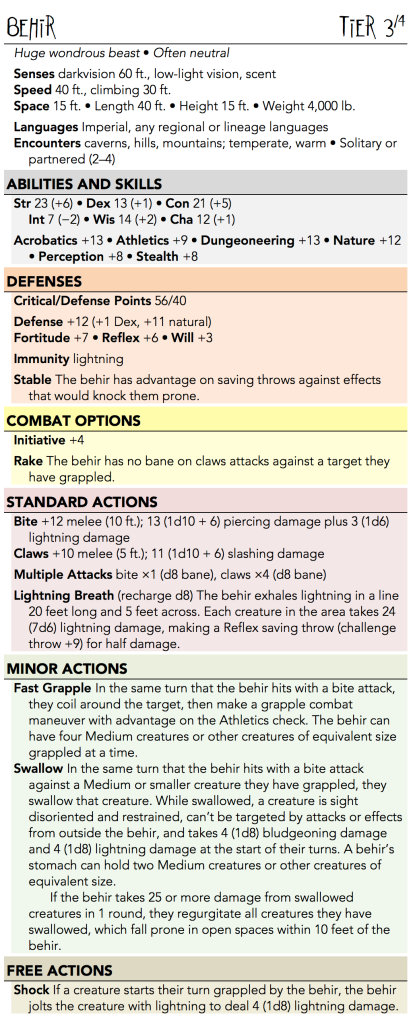Creature statistics have been a very moveable feast since the earliest days of D&D. The monster stat block has undergone steady mutation through varyingly complex forms, both in the main game line and many of the games that have split off from D&D.
In the early days of AD&D, creature statistics were sparse, amounting to bare combat stats, size, and a rough intelligence rating that was the only reference to a creature’s ability scores. In the 3rd edition days, monster statistics expanded with more details but inherited a scattered flow of information from AD&D. Not until the later stages of D&D v3.5 did the concept of the organized stat block finally emerge, to be inherited by D&D 5e and many other d20-based RPGs — including CORE20.
Years in the Making!
The creatures, monsters, and other foes who fill the CORE20 Playtest Creature Package were one of the very last pieces of the game to come together. Prior to that, during the alpha playtest, I and a small number of brave GMs played the game using stock D&D 3.5 monsters updated on the fly for new rules and conditions, and with a very loose reckoning of how the challenge ratings of 3.5e translated to CORE20’s looser encounter building.
As a result, I had a lot of time to think about what a CORE20 creature stat block might and should look like. And a thing I thought a lot about during that time was how to move away from the 3.5e and 5e approach that views stat blocks mostly as a summary of a creature’s ability to kill the characters or to be killed in return.
Full disclosure: the CORE20 stat block is still mostly about combat, for the simple reason that CORE20 is a game that absolutely knows how much fun it is to fight monsters. But one of the things I thought about for a long time through the alpha playtest was how to work up a stat block that didn’t imply that combat was the only purpose of the game, and that didn’t intentionally make every potentially useful bit of noncombat information as hard to find as possible.
As such, the setup I came up with in 2023 for the CORE20 stat block starts with noncombat options, then works its way down into more-violent action options. And as I tweaked and fine-tuned a few early attempts at the setup, I realized that what I ended up doing reflected an overall general approach to how monster encounters typically play out. (The Playtest Creature Package talks about this setup as well.)

Top Down
When the characters first notice a monster, it’s often important to determine whether or not the monster notices them back — and how fast the monster moves toward the party if they do. That’s why the Senses and Speed lines are at the top of the stat block. Size is next because if a creature is moving toward the characters, the first thing they likely notice is how big or small the creature is, and how scared they should be as a result. Languages below that sets the scene for what kind of threats or parley might be in the offing before contact between creature and characters is made. Encounters then suggest what other creatures might be lurking nearby and unobserved, waiting to see how that initial contact plays out.
Below that initial section of the stat block, a number of color-coded sections then dig into the mechanics-focused interactions between creature and characters. Abilities and Skills are first up, whether the GM is setting up a social encounter or needs to tap into skill checks for combat maneuvers, characters or monsters hiding from each other, and so forth. Then, for the many times when combat is the way an encounter is meant to go, the lower sections of the stat block focus on what a creature needs to get into the fight.
Defenses are first up in the combat portion of the stat block, to highlight the idea that even in combat, it’s okay for creatures to focus first and foremost on avoiding taking damage before focusing on dealing it out. A Combat Options section follows, incorporating initiative and any other always-on combat-specific features. Sections covering Standard Actions, Minor Actions, Move Actions, Free Actions, and Reactions then make up the bulk of the stat block, setting out a creature’s round-by-round action options in order of the effort involved in using them.
Pretty Colors
The color coding of the stat block from Abilities and Skills down is another thing that developed over years of thinking about what a CORE20 stat block might look like — as a direct result of my addled brain always having found it really difficult to parse the 3.5e stat block and many of its d20 descendants. With each part of the stat block coded with a specific background color, it makes it easy to quickly focus on a specific section as one gets used to that coding. When I’m setting up an encounter, I know that yellow and a creature’s initiative modifier is the first thing I look for. When a creature’s turn comes up each round, I know to look to red first for the standard actions that are a creature’s primary focus, then glance at the green minor actions to remind myself what else they can do.
The current color presentation is focused on the playtest, and there’s a version of the Playtest Creature Package that keeps the header colors but loses the background colors for folks who find that easier to read. Though the look and layout of the CORE20 books is only in its most preliminary stages at this point, the vision for the final stat block setup is a little bit more subdued than the playtest’s Microsoft Word formatting allows. Here’s a sneak preview of that setup featuring the behir again (one of my favorite monsters), as rendered by one of my favorite artists, the amazing Jackie Musto.
(Art by Jackie Musto — http://www.jackiemustoart.com)

